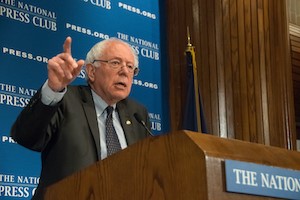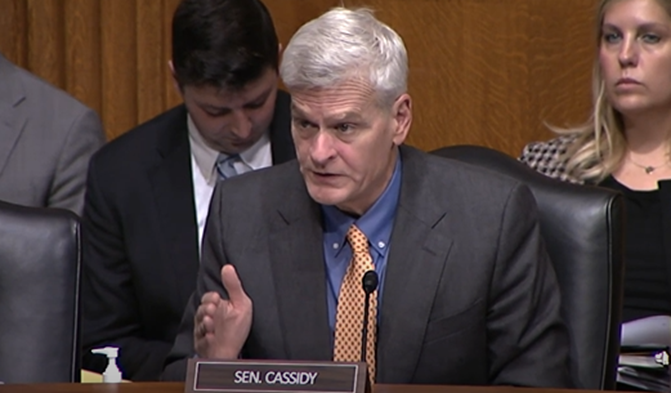A hearing that was billed as “taking a serious look at the retirement crisis in America” with a focus on improving the defined benefit system ended with witnesses agreeing that some reforms are needed, but calling for drastically different measures.
The Feb. 28 hearing was held by the Senate Health, Education, Labor and Pensions (HELP) Committee, which is chaired by Sen. Bernie Sanders (I-Vt.). Included among the single panel of witnesses testifying were:
- Teresa Ghilarducci, Irene and Bernard L Schwartz Professor of Economics and Policy Analysis at The New School for Social Research;
- Eric Stevenson, President of Nationwide Retirement Solutions;
- Dan Doonan, Executive Director of the National Institute on Retirement Security;
- Rachel Greszler, Senior Research Fellow at The Heritage Foundation; and
- Sara Schambers, UAW Member, Local 182, Ford Livonia Transmission.
While the American Retirement Association (ARA) did not testify at this hearing, the underlying topic has been of keen interest to the organization, particularly as recent efforts have bubbled up in policymaking circles to dismantle or undermine the employer-provided retirement savings system.
For example, some of the witnesses argued that the employer-provided retirement system has failed and suggested that a federal retirement plan similar to the Thrift Savings Plan (TSP) should be implemented, while others contended that the system is working and that the improvements made under SECURE 1.0 and 2.0 should be given time to work.
For his part, Chairman Sanders kicked the hearing off by suggesting that every corporation in America should be required to provide a retirement plan, and if they don’t, then individuals should be given the opportunity to participate in a program that is equivalent to the plans that members of Congress receive. The senator also called for expanding Social Security by lifting the payroll cap to help pay for it.
In contrast, the Senate HELP Committee’s ranking member, Sen. Bill Cassidy, M.D. (R-La.), observed that the focus of the hearing on promoting the DB system is a “bit puzzling,” noting that it seems to prescribe an agenda that is outdated and disconnected from reality. 
“The Chair speaks of needing to find a solution to a crisis, but we already have a solution,” Sen. Cassidy stated in pointing to Congress passing the SECURE 2.0 Act on a bipartisan basis to make improvements to our nation’s retirement system. “We had the option to take an approach like the one the Chair is advocating for and chose not to. Instead, we based the solution primarily on the success of the defined contribution system,” Sen. Cassidy added.
What’s more, the ranking member noted that there are still provisions of SECURE 2.0 that have not even taken effect yet, including those to help low-income individuals, such as the enhanced Saver’s Match, which goes into effect in 2027.
As to expanding the DB system, Cassidy observed that many multiemployer plans had been struggling for years and were widely mismanaged, but congressional Democrats passed a $90 billion bailout on a party-line vote, without any strings attached. “This is the same system that the Chair wants us to expand,” Cassidy stated inquisitively.
ARA Statement
In a statement for the record, the ARA noted, among other things, that DC plans work for those with access, and that SECURE 2.0, state plans, and auto-IRAs are helping to close the coverage gap. The organization also argued that the Retirement Savings for Americans Act (RSAA) will decimate the employer-sponsored retirement system.
“The most concerning feature of [RSAA] is the inclusion of the taxpayer-funded Government Match provision, which is only accessible to individuals who do not currently have access to an employer-sponsored retirement plan,” the statement read. “The inclusion of a Government Match creates a perverse incentive for employers, particularly small employers with razor-thin margins, to shutter their existing retirement plans so that their workers are eligible to be enrolled in the Fund. This would harm certain retirement savers because many of these plans that would be eliminated have more generous employer matching rates than the Government Match.”
Witnesses at Odds
Of the witnesses, Eric Stevenson of Nationwide Retirement Solutions—who was essentially the lone non-union, private-sector witness—took perhaps the most even-handed approach with his testimony. He argued that both the DB and DC systems have upsides, and that policymakers should take the best of both systems and move beyond the unfavorable provisions.
“The SECURE Act of 2019 and SECURE 2.0 Act of 2023 were huge steps forward in this effort, creating opportunities for employers to offer in-plan protected retirement solutions. We’ve launched an entire suite of these products and are seeing strong traction in adoption among plan sponsors and participants,” Stevenson testified. “As we think about the next iteration of retirement legislation, finding more opportunities to help retirement savers address the decumulation challenge should be a top priority,” he added.
Interestingly, Stevenson was asked by Sen. Ted Budd (R-N.C.) for his opinion about whether he believes the Department of Labor’s (DOL) currently proposed fiduciary rule would further restrict access and advice, and whether the approach would be incompatible with the current system. In response, the Nationwide executive suggested that the DOL’s proposal is so broad that it’s a major distraction and expense, and has the potential to leave people worse off; he further contended that policymakers and the industry should focus more on the provisions in SECURE 1.0 and 2.0.
During the hearing’s Q&A period, Sens. Maggie Hassan (D-N.H.) and Budd noted that they will be introducing the Senate companion to the House’s RISE Act to address a “snafu” that is preventing the smallest of employers from getting the tax credit to cover start-up costs for establishing a DC plan. Stevenson noted that these tax credits for small businesses are hugely important, and that he supports anything that will make it easier for them to offer a plan.
Similarly, when Sen. Robert Casey, Jr. (D-Pa.) asked Stevenson about his legislation that would help children start saving early for retirement by establishing a savings account for every child in America, Stevenson noted that he always agrees with starting to save early in life.
Teresa Ghilarducci, meanwhile, in contending that the bottom 50% of median-wealth households have no retirement savings beyond Social Security and no home equity, argued that the system has failed and needs to be reformed.
To that end, she suggested that the American pension system lacks three basic elements: (1) allowing workers to accumulate money over their careers, (2) investing their retirement savings “well,” and (3) ensuring they don’t outlive their assets. With that as a backdrop, she called for a TSP-like plan for private-sector workers, like the RSAA introduced by Sens. John Hickenlooper (D-Colo.) and Thom Tillis (R-N.C.). She noted this legislation would meet the basis of the three-prong test she outlined.
“If every worker without a plan had access to the elegant and well-designed retirement plan that every member of Congress and federal employee has, we would make big leaps in updating our system and securing retirement for all Americans. Fortunately, we now have that opportunity,” Ghilarducci stated.
Dan Doonan echoed a lot of what Ghilarducci stated regarding overall retirement readiness, but argued that companies should revisit offering pensions, which he contended is the “most cost-efficient way” of delivering retirement security. Accordingly, the NIRS executive director referenced IBM’s recent announcement that it was going to replace their matching contribution in their 401(k) with an employer contribution to a cash balance plan as one example of employers giving pension another look. He said:
“If we are serious about rebuilding retirement security for Americans, increasing pension coverage must be part of the retirement equation. And the ground indeed is shifting with respect to employers offering pensions, likely driven by several factors such as employers’ desire to provide retirement benefits in the most cost-effective manner, employees’ desire for lifetime income, and the critical need to recruit and retain workers amid an increasingly tight labor market.”
Doonan also echoed a lot of what was included in a NIRS white paper that was released Feb. 27, the day before the hearing.
Meanwhile, in contrast to Ghilarducci and Doonan, Rachel Greszler of The Heritage Foundation contended that, while older generations are better off financially than younger generations, the current trends do not indicate that younger Americans are unprepared for retirement or that it makes sense for them to increase savings and forgo consumption in exchange for higher future consumption.
Greszler also pointed out that Social Security is in crisis as the program will be insolvent in just nine years, and every single retiree will be subject to 23% benefit cuts, averaging $5,300 per retiree.
“Every year that policymakers delay action means trillions of dollars more in either benefit cuts or tax increases. Policymakers should act immediately to preserve Social Security for those who need it most and to improve the program for current workers and future generations,” Greszler testified.
The Heritage Foundation fellow threw further cold water on talks of expanding DB plans, noting, for example, that DB multiemployer and state and local pension funds “are in disastrous shape,” and adding that taxpayers have already bailed out select private multiemployer or union pension plans.
“Comparisons should never be made between defined benefit plans that would be bankrupt without taxpayer funds and defined contribution plans that have not received taxpayer bailouts,” Greszler emphasized. “The last thing that Americans need is to put more money into a failing system.”
A replay of the hearing can be viewed here.
The ARA's statement for the record can be viewed here.
- Log in to post comments
